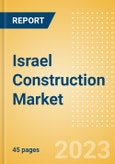3 Context
3.1 Economic Performance
3.2 Political Environment and Policy
3.3 Demographics
3.4 Risk Profile
4 Construction Outlook
4.1 All Construction
- Outlook
- Latest news and developments
- Construction Projects Momentum Index
4.2 Commercial Construction
- Outlook
- Project analytics
- Latest news and developments
4.3 Industrial Construction
- Outlook
- Project analytics
- Latest news and developments
4.4 Infrastructure Construction
- Outlook
- Project analytics
- Latest news and developments
4.5 Energy and Utilities Construction
- Outlook
- Project analytics
- Latest news and developments
4.6 Institutional Construction
- Outlook
- Project analytics
- Latest news and developments
4.7 Residential Construction
- Outlook
- Project analytics
- Latest news and developments
5 Key Industry Participants
5.1 Contractors
5.2 Consultants
7 Appendix
7.1 What is this Report About?
7.2 Definitions
7.3 CRI Methodology
- About the Analyst
- Contact the Publisher
List of Tables
Table 1: Construction Industry Key Data
Table 2: Israel, Key Economic Indicators
Table 3: Israel, Commercial Construction Output by Project Type (Real % Change), 2020-29
Table 4: Israel, Top Commercial Construction Projects by Value
Table 5: Israel, Industrial Construction Output by Project Type (Real % Change), 2020-29
Table 6: Israel, Top Industrial Construction Projects by Value
Table 7: Israel, Infrastructure Construction Output by Project Type (Real % Change), 2020-29
Table 8: Israel, Top Infrastructure Construction Projects by Value
Table 9: Israel, Energy and Utilities Construction Output by Project Type (Real % Change), 2020-29
Table 10: Israel, Top Energy and Utilities Construction Projects by Value
Table 11: Israel, Institutional Construction Output by Project Type (Real % Change), 2020-29
Table 12: Israel, Top Institutional Construction Projects by Value
Table 13: Israel, Residential Construction Output by Project Type (Real % Change), 2020-29
Table 14: Israel, Top Residential Construction Projects by Value
Table 15: Israel, Key Contractors
Table 16: Israel, Key Consultants
Table 17: Israel, Construction Output Value (Real, $ Million)
Table 18: Israel, Construction Output Value (Nominal, ILS Million)
Table 19: the analyst Construction Market Definitions
Table 20: Risk Dimensions
Table 21: Ratings, Scores and Definitions
List of Figures
Figure 1: Middle East and North Africa, Construction Output (Real % Change), 2023-29
Figure 2: Israel, Construction Output by Sector (Real % Change), 2023-25 and 2026-29
Figure 3: Israel, Risk Summary
Figure 4: Israel, Risk Regional Comparison
Figure 5: Israel, Construction Output Value (Real, $ Million, 2022 Prices and Exchange Rate), 2020-29
Figure 6: Israel, Construction Output Value, by Sector (Real, $ Million), 2020-29
Figure 7: Israel, Construction Value-add (ILS Million, 2015 Chained Prices)
Figure 8: Israel, Gross Capital Formation in Construction (ILS Million, 2015 Chained Prices)
Figure 9: Israel, Unemployment (In thousands)
Figure 10: Israel, Employment in Construction Industry (In thousands)
Figure 11: Israel, Israel, Total Area Authorized for Residential and Non-Residential Buildings (Thousands m2)
Figure 12: Israel, Total Area Authorized for Residential and Non-Residential Buildings on Which Construction Were Started (Thousands m2)
Figure 13: Israel, Construction Projects Momentum Index
Figure 14: Middle East and North Africa, Construction Projects Momentum Index
Figure 15: Israel, Commercial Construction Output by Project Type (Real, $ Million), 2020-29
Figure 16: Israel, Commercial Construction Projects Pipeline, Value by Stage ($ Million)
Figure 17: Israel, Wholesale and Retail Trade, Accommodation and Food Services Value-Add (ILS Million, 2015 Chained Prices)
Figure 18: Israel, Total International Tourist Arrivals
Figure 19: Israel, Total Area Authorized for Office Buildings (In Thousands m2)
Figure 20: Israel, Total Area Authorized for Office Buildings on which construction started (In Thousands m2)
Figure 21: Israel, Industrial Construction Output by Project Type (Real, $ Million), 2020-29
Figure 22: Israel, Industrial Construction Projects Pipeline, Value by Stage ($ Million)
Figure 23: Israel, Manufacturing, Mining and Quarrying Value-Add (ILS Million, 2015 Chained Prices)
Figure 24: Israel, Total Area Authorized for Manufacturing and Storage Premises (Thousands m2)
Figure 25: Israel, Total Area Authorized for Manufacturing and Storage Premises on which construction started (Thousands m2)
Figure 26: Israel, Total Export Value (ILS, Million)
Figure 27: Israel, Infrastructure Construction Output by Project Type (Real, $ Million), 2020-29
Figure 28: Israel, Infrastructure Construction Projects Pipeline, Value by Stage ($ Million)
Figure 29: Israel, Road and Bridging Construction Inputs Prices Index (2011=100)
Figure 30: Israel, Energy and Utilities Construction Output by Project Type (Real, $ Million), 2020-29
Figure 31: Israel, Energy and Utilities Construction Projects Pipeline, Value by Stage ($ Million)
Figure 32: Israel, Information and Communication Value-Add (ILS Million, 2015 Chained Prices)
Figure 33: Israel, Institutional Construction Output by Project Type (Real, $ Million), 2020-29
Figure 34: Israel, Institutional Construction Projects Pipeline, Value by Stage ($ Million)
Figure 35: Israel, Total Area Authorized for education and healthcare buildings (Thousands m2)
Figure 36: Israel, Total Area Authorized for Education and Healthcare Buildings on Which Construction Were Started (Thousands m2)
Figure 37: Israel, Residential Construction Output by Project Type (Real, $ Million), 2020-29
Figure 38: Israel, Residential Construction Projects Pipeline, Value by Stage ($ Million)
Figure 39: Israel, Gross Capital Formation in Residential Buildings (ILS Million, 2015 Chained Prices)
Figure 40: Israel, Total Authorized Residential Area (Thousand m2)
Figure 41: Israel, Total Authorized Area on which Construction Works of New Residential Buildings have Started (Thousand m2)
Figure 42: Israel, Housing Construction Inputs Prices Index (2011=100)
Figure 43: Israel, Housing Loans (in ILS Million)
Figure 44: Israel, Headquarters of Key Contractors (% of Total Project Pipeline)
Figure 45: Israel, Headquarters of Key Consultants (% of Total Project Pipeline)








